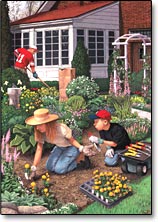
During my recent visit, I was amazed at the selection of seeds at the nearby garden center!
Here are seeds to add to our Herbal Treasures Garden in the 2009 growing season:
Celosia, Red Velvet
Centaurea, Imperial Bouquet Mix
Cornflower, Tall Mixed Flowers
Cosmos, Summer Dreams & Summer Sunshine Mix
Marigold, Calendula Apricot Daisy, Citrus Mix & Cottage Red
Moonflower, Giant White
Nasturtium, Empress of India, Jewel Mix, Lipstick & Papaya Cream
Passion Flower, Blue (Heirloom!)
Zinnia, Candy Cane Red on White & Envy (Heirloom!)
Veggies go great with herbs and fresh-cut flowers from the garden, so I also chose:
Mesclun, Salad Mix, Spicy Mix & Sweet Salad Mix
Tomato, Yellow Pear
Now, a sage word of advice to all those other rampant-to-get-started gardeners out there, also bitten by the ‘spring bug’:
- When purchasing your seed packets, be sure to read the information about the plant on the back of the package. Find out when you need to start the seeds.
- For some, you may need to begin them indoors, several weeks in advance. Be sure to not begin immediately planting them outdoors, unless you live in a climate that is already in the growing season.
- Avoid the great temptation to begin your garden ‘early,’ under the often false impression that spring has come early, only to lose the fruits of your labor, with the frost nipping them all in the bud.
Next: I will share with you a lucious-sounding collection of bulbs that we are eagerly anticipating their appearance this spring!
What are your garden plans for the 2009 growing season?
Please leave a comment and share a bit of your garden and your plans with us here…
 Safety is a concern even when gardening. If you use chemicals of any kind, fertilizers, and pesticides be sure to thoroughly read the label and follow the instructions. This is one are that is often neglected — much to the peril of the gardener or dire results in the garden, from not following instructions properly.
Safety is a concern even when gardening. If you use chemicals of any kind, fertilizers, and pesticides be sure to thoroughly read the label and follow the instructions. This is one are that is often neglected — much to the peril of the gardener or dire results in the garden, from not following instructions properly.




